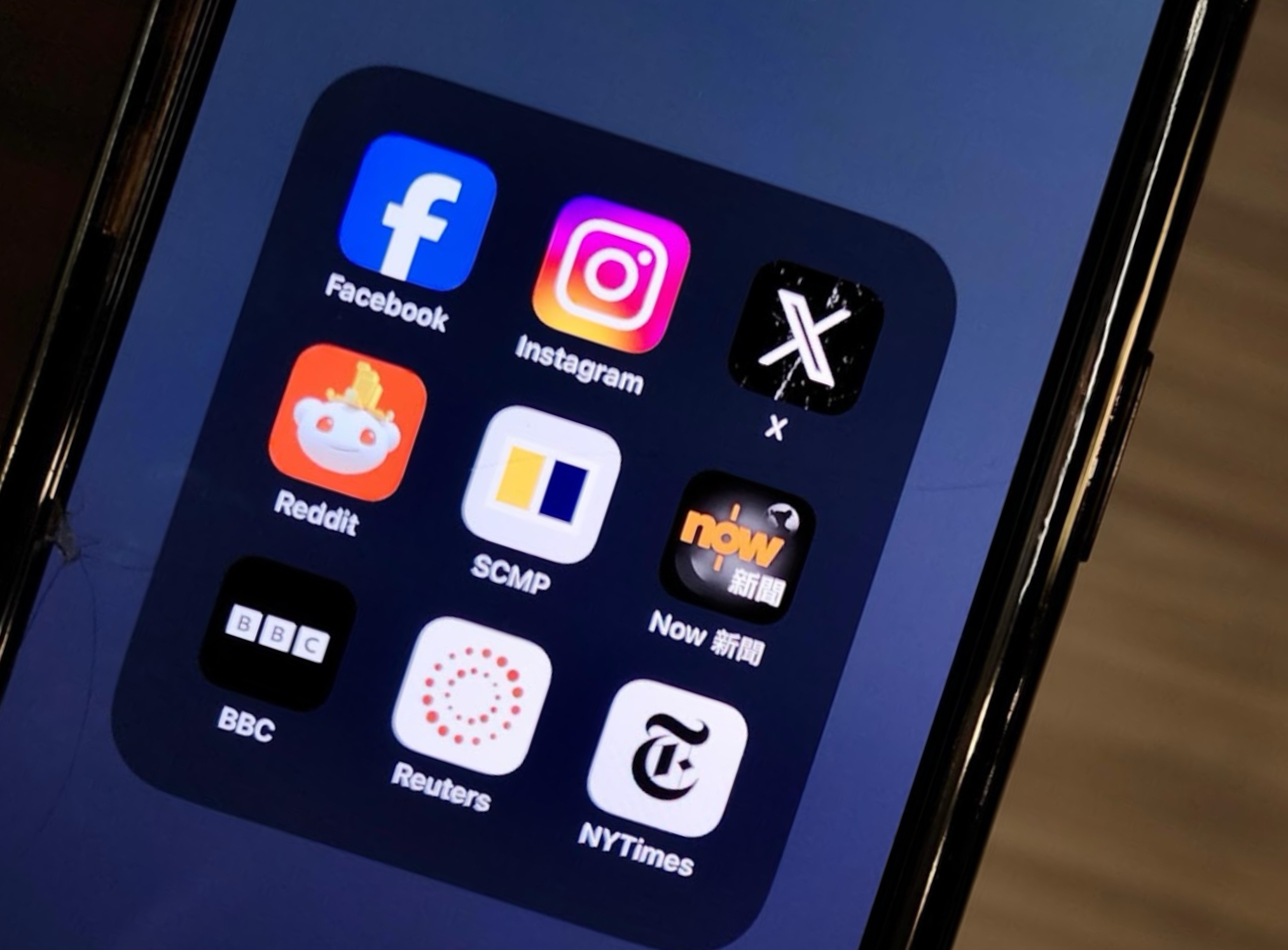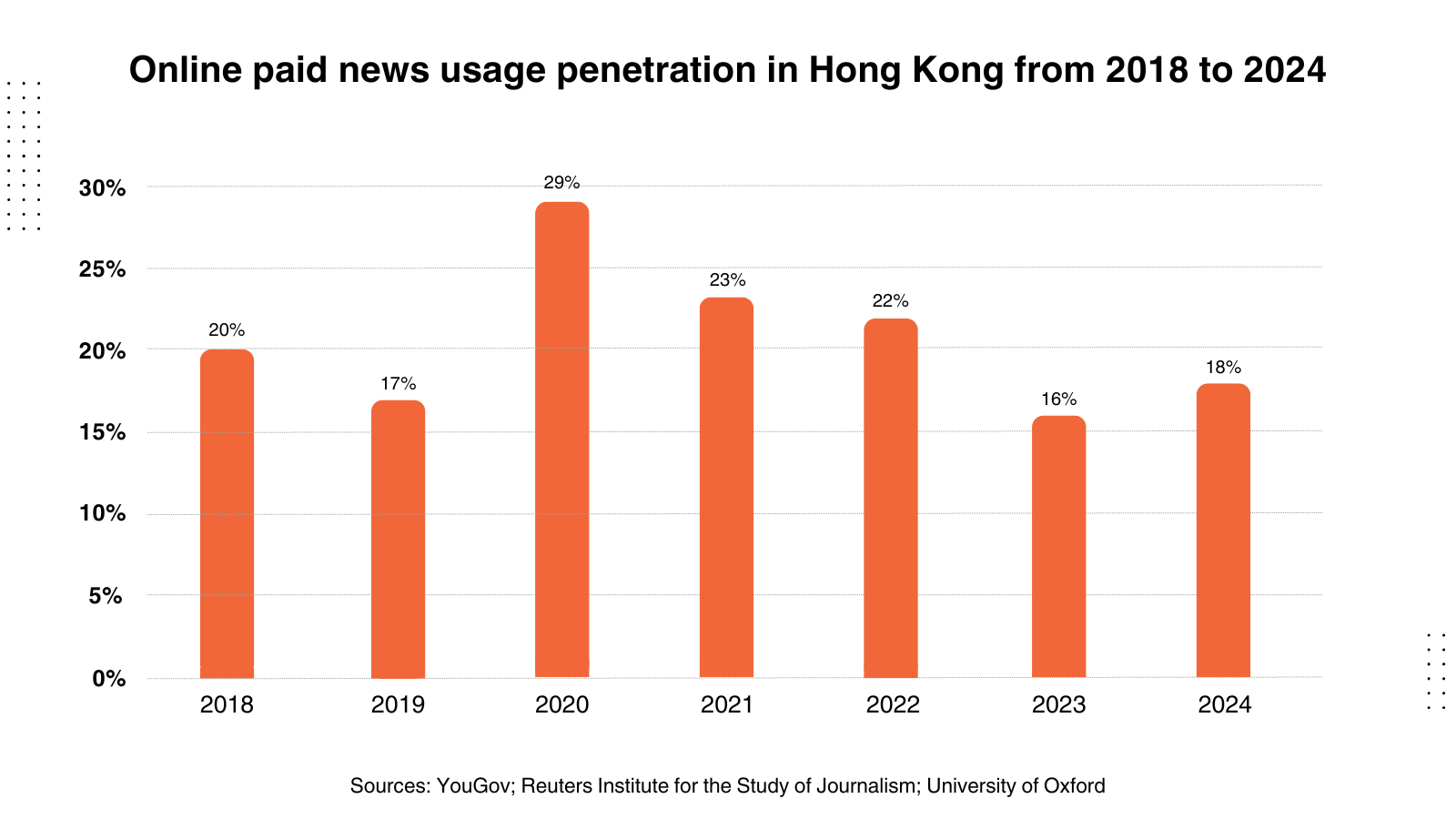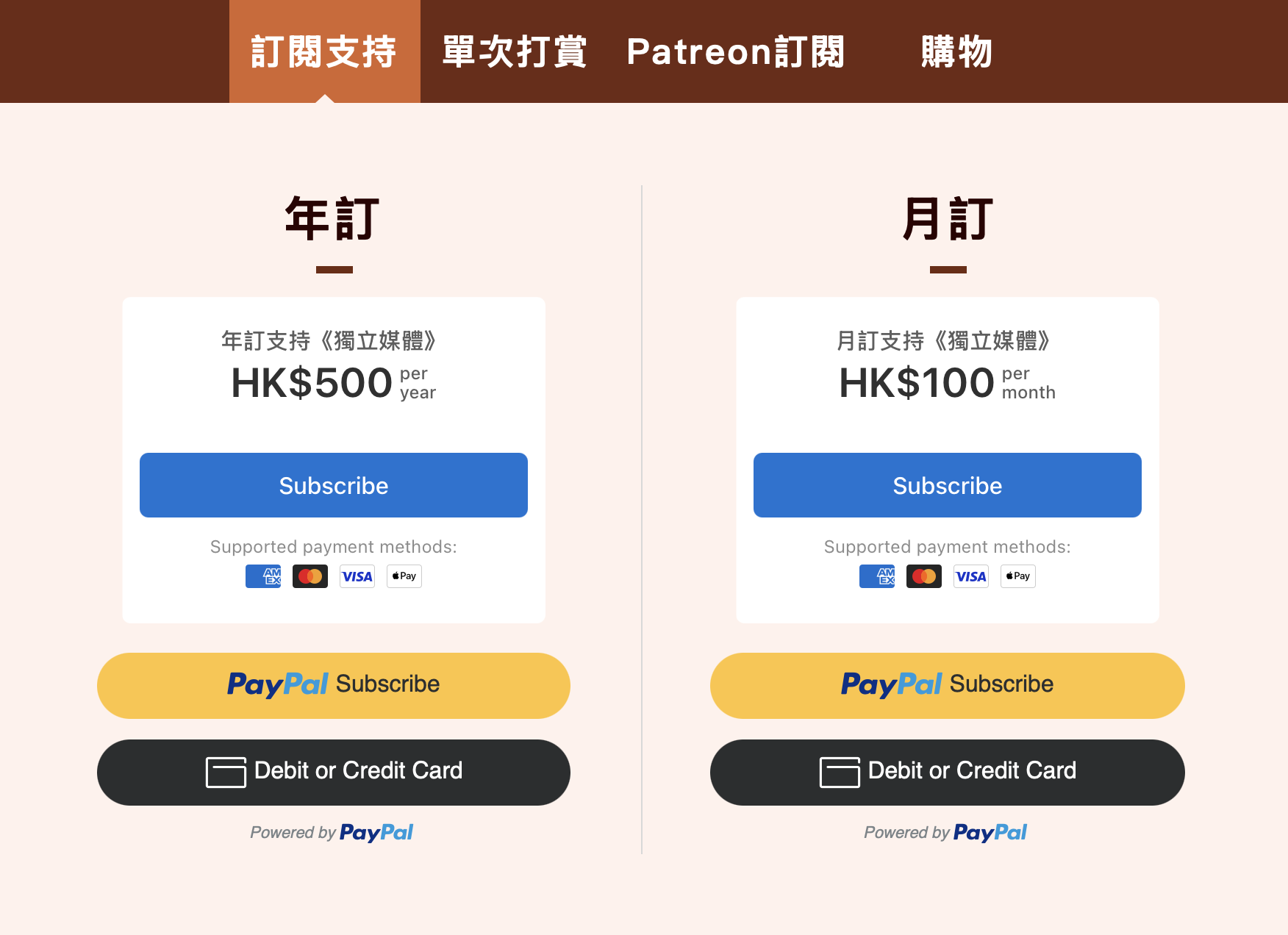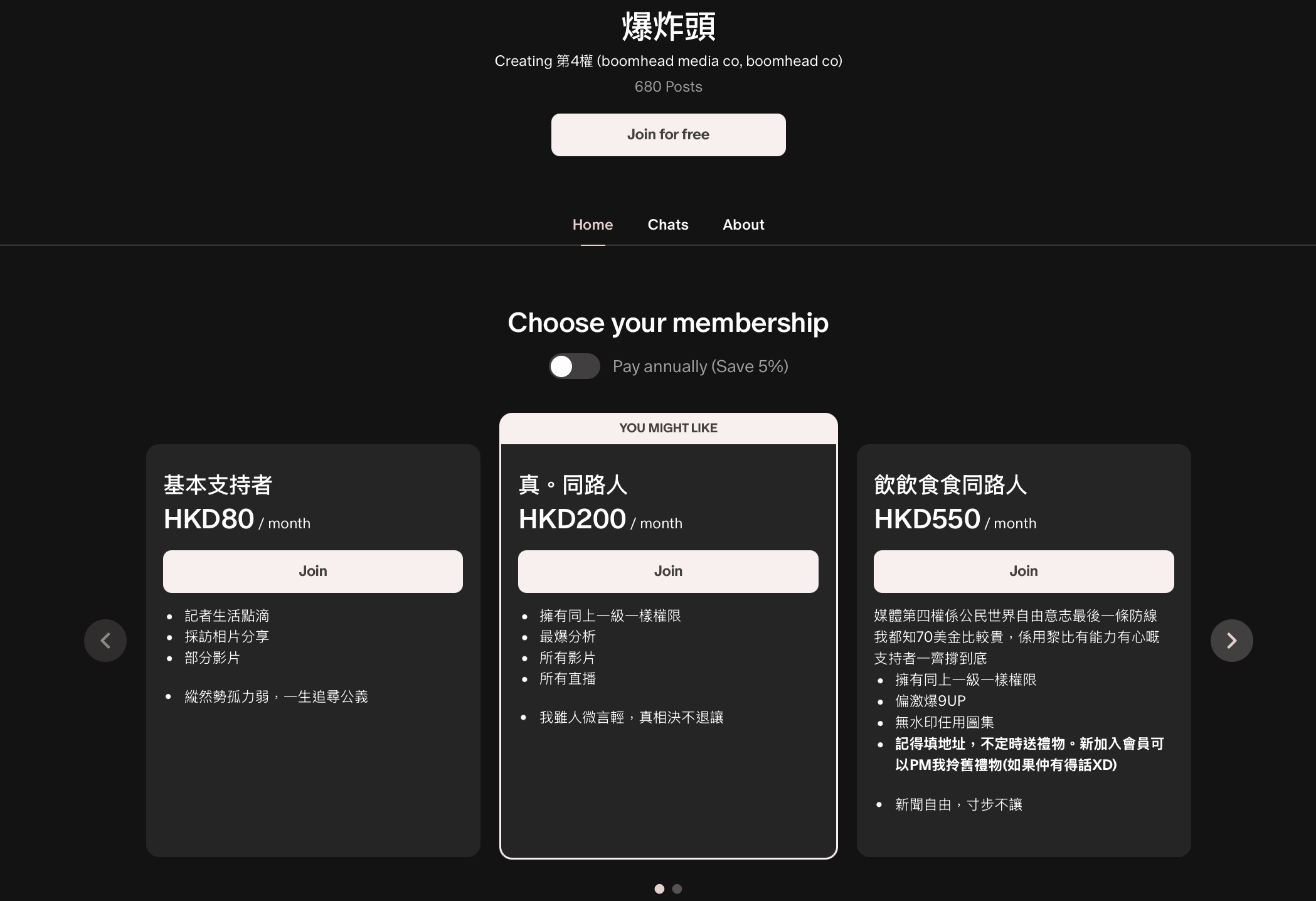
Tang Ho-wing, 36, is an independent journalist running the news outlet, “boomheadhk”, on social media platforms such as Facebook and Instagram. The page mostly covers local and international political issues, and has attracted over 22,700 followers.
“Hongkongers' news consumption habits have shifted. Increasingly, they want to consume content not covered by the mainstream media or specialised content that features unique views,” Tang said.
The main purpose of his outlet is to supplement the mainstream media and offer readers new insights on social issues.
Tang’s outlet relies on readers’ donations to cover the cost of his reporting work.
“When people want to read more specialised and unique reporting, or lesser-known content, they are willing to pay,” Tang said.

According to Reuters Institute Digital News Report, in an online survey of 2,000 respondents in Hong Kong, only 18% said they pay to access news online in 2024, down from the peak of 29% in 2020.
The report added that because the public’s news consumption habits have changed and advertising revenue has declined, media organisations that struggle in adapting to the rapid change have reported financial losses.
Hong Kong Free Press, an independent non-profit news media that relies on readers’ donations, reported a HK$1.4 million loss in 2023, according to its annual report. HKFP has 895 regular monthly donors as of 2023.
Damon Wong Chun-pong, Chief Editor of InMedia, a local online independent news outlet, said his outlet did not experience significant financial losses.
“The drop in paid readership following 2020 is a full picture that includes the closure of mainstream media outlets, such as Apple Daily and Stand News,” said Wong. “By comparison, our readership didn’t drop a lot.”
He said some readers follow other small and new news outlets after some closure of some of the mainstream outlets. The newcomers include TheWitness, which focuses on reporting legal and court news.
Currently, InMedia relies on a mix of subscriptions, one-time donations and advertisements as its revenue model. According to Wong, subscriptions comprise 90% of the revenue, while the remaining 10% comes from advertisements.

Dr. Connie Chan Oi-yan, Senior Lecturer of the School of Communication of the Hang Seng University of Hong Kong, said the development of online news consumption and its revenue models can be explained by the political economist theory of “audience commodity.”
“The relationship between news outlets, readers and advertising companies is a symbiotic relationship,” said Chan. “When a news outlet publishes high quality content, it will naturally attract more readers and subscribers who are willing to pay. At the same time, more subscribers will attract more advertising companies to put ads in the news outlet, allowing it to earn more revenue.”
Chan said because new media priorities fast distribution of information, news content from different outlets has become similar. The emergence of many new media platforms resulted in information overlapping with one another.
“How we differentiate a good news outlet from the rest,” said Chan, “only those that can provide fast, accurate and in-depth information can attract more readers.”
“This type of in-depth information is a commodity, which is valuable,” Chan said.
“I would say more people prefer accessing news on free media outlets and social media,” said Chau King-hin, a first-year journalism student from the University of Hong Kong.
Chau had never subscribed or donated to any news outlets.
“For me, free journalistic work can provide similar quality as the paid ones,” he said.
Dr. Joseph Louis Travis, Lecturer of the School of Journalism and Communication at the Chinese University of Hong Kong, said news media adopt a donation-based revenue model because they want to present themselves as unbiased and non-affiliated.
“Asking for donations to ensure quality of service and unbiased material is ideal for a lot of developing young journalists,” said Travis. “With a donation model, they can say they are independent, and it's true, clean and trustworthy reporting.”
On the other hand, Tang said relying purely on donations is not enough to cover the cost of his outlet.
“Honestly, my outlet is not a big one, I don’t have any fame effect like journalists from Stand News or other media who decided to become independent journalists after their outlets closed,” said Tang. “I can only try to cut costs in other areas, such as not using the best cameras and best computers, and use cheaper ones to keep the cost low instead.”

Tang’s page, Boomhead Media, currently fully relies on donations from Patreon. Unlike InMedia, Boomhead Media operates without advertising revenue. Tang said he has no plans to include advertising.
“Getting into the advertising business may limit the news you can report on, because you have to consider the business interests of the advertisers,” said Tang. “You may not be able to publish a certain kind of content under the pressure of advertising companies, which will affect the partiality of the outlet’s content.”
Maintaining editorial impartiality and neutrality while relying on donations is also a main goal for InMedia.
Wong said InMedia does not have major patrons that influence their content. He added because each donor contributes only a small amount, they are not significant enough to impact their content’s impartiality.
“We do not please our readers or attract donors by tweaking our news content, but we would organise some internal activities or guided tours exclusively for our donors," Wong said.
Tang said Boomhead Media has a clear distinction between news reporting and commentaries to remain impartial.

“Previously many media would have a line or two at the end of each article as a criticism or commentary, but in today’s reporting they have all been removed,” Tang said.
Chau said sometimes independent news outlets have no clear references to online sources and distinct fact-checking procedures, and it makes him doubt their credibility.
“Media bias is kind of common nowadays, that’s why fairness and diverse perspectives are my main considerations in deciding to pay for news or not,” said Chau.
He added that while news outlets try to remain impartial, readers need to develop their media literacy to determine what information is truthful.
“If the readers wish for high-quality content, they should acknowledge the required running costs, including equipment and manpower expenses to maintain immediate and accurate reporting,” Chan said.
“Sometimes it is hard for news outlets to conduct journalistic gatekeeping perfectly. Even though each outlet has its own media policy, there is just too much information available online. That’s why readers should also determine for themselves what is right,” said Chan.
Similarly, Travis said the public should not take impartiality as granted and cannot demand that from news sources, and readers have to find sources they trust themselves.
“The public will show their interest based on news outlets they’re willing to put their money and time into,” said Travis. “It’s up to the news outlets to respond accordingly.”
《The Young Reporter》
The Young Reporter (TYR) started as a newspaper in 1969. Today, it is published across multiple media platforms and updated constantly to bring the latest news and analyses to its readers.

Taxi industry demands for consummate policy under threats in hailing car ecology

Hong Kong seizes crypto opportunities as Consensus’ Asian host




Comments